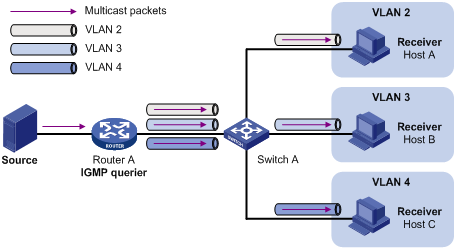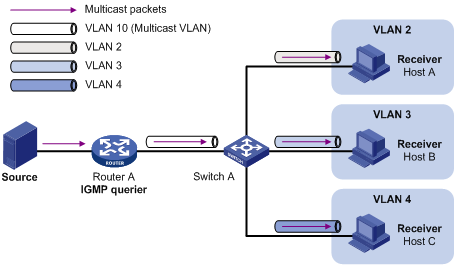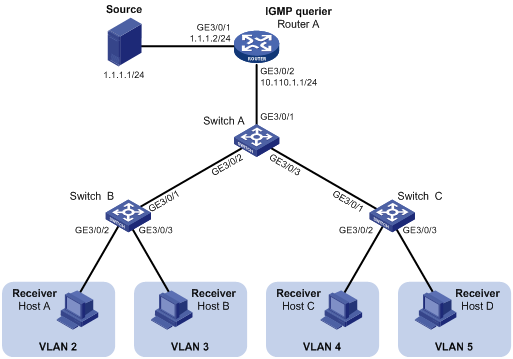- Table of Contents
-
- 08-IP Multicast Configuration Guide
- 00-Preface
- 01-Multicast Overview
- 02-IGMP Snooping Configuration
- 03-PIM Snooping Configuration
- 04-Multicast VLAN Configuration
- 05-Multicast Routing and Forwarding Configuration
- 06-IGMP Configuration
- 07-PIM Configuration
- 08-MSDP Configuration
- 09-MBGP Configuration
- 10-Multicast VPN Configuration
- 11-MLD Snooping Configuration
- 12-IPv6 PIM Snooping Configuration
- 13-IPv6 Multicast VLAN Configuration
- 14-IPv6 Multicast Routing and Forwarding Configuration
- 15-MLD Configuration
- 16-IPv6 PIM Configuration
- 17-IPv6 MBGP Configuration
- Related Documents
-
| Title | Size | Download |
|---|---|---|
| 04-Multicast VLAN Configuration | 168.57 KB |
Contents
Multicast VLAN configuration task list
Configuring the maximum number of forwarding entries in a multicast VLAN
Displaying and maintaining a multicast VLAN
Multicast VLAN configuration example
|
|
NOTE: In this chapter, the switch functions as a Layer 2 device (referred to as Switch in network diagrams); configurations for a Layer 3 device (referred to as Router in network diagrams) are implemented on an H3C router. |
Multicast VLAN overview
In the traditional multicast programs-on-demand mode shown in Figure 1, when hosts (Host A, Host B and Host C) that belong to different VLANs require multicast programs-on-demand service, the Layer 3 device (Router A) must forward a separate copy of the multicast traffic in each user VLAN to the Layer 2 device (Switch A). This results in not only waste of network bandwidth but also extra burden on the Layer 3 device.
Figure 1 Multicast transmission without the multicast VLAN feature

The multicast VLAN feature configured on the Layer 2 device is the solution to this issue. With the multicast VLAN feature, the Layer 3 device replicates the multicast traffic only in the multicast VLAN instead of making a separate copy of the multicast traffic in each user VLAN. This saves network bandwidth and lessens the burden on the Layer 3 device.
The multicast VLAN feature can be implemented in a sub-VLAN-based multicast VLAN.
As shown in Figure 2, Host A, Host B and Host C are in three different user VLANs. On Switch A, configure VLAN 10 as a multicast VLAN, configure all user VLANs as sub-VLANs of this multicast VLAN, and enable IGMP snooping in the multicast VLAN.
Figure 2 A sub-VLAN-based multicast VLAN

After the configuration, IGMP snooping manages router ports in the multicast VLAN and member ports in the sub-VLANs. When forwarding multicast data to Switch A, Router A needs to send only one copy of multicast traffic to Switch A in the multicast VLAN, and Switch A distributes the traffic to the multicast VLAN’s sub-VLANs that contain receivers.
Multicast VLAN configuration task list
Complete the following tasks to configure multicast VLAN:
|
Task |
Remarks |
|
Required |
|
|
Configuring the maximum number of forwarding entries in a multicast VLAN |
Optional |
Configuring a multicast VLAN
Configuration prerequisites
Before you configure a sub-VLAN-based multicast VLAN, complete the following tasks:
· Create VLANs as required.
· Enable IGMP snooping in the VLAN to be configured as a multicast VLAN.
Configuring a multicast VLAN
In this approach, you need to configure a VLAN as a multicast VLAN, and then configure user VLANs as sub-VLANs of the multicast VLAN.
To configure a sub-VLAN-based multicast VLAN:
|
Step |
Command |
Remarks |
|
1. Enter system view. |
system-view |
N/A |
|
2. Configure the specified VLAN as a multicast VLAN and enter multicast VLAN view. |
multicast-vlan vlan-id |
By default, a VLAN is not a multicast VLAN. |
|
3. Assign the specified VLANs to the multicast VLAN. |
subvlan vlan-list |
By default, a multicast VLAN has no sub-VLANs. |
|
|
NOTE: · You cannot configure a multicast VLAN on a device with IP multicast routing enabled. · The VLAN to be configured as a multicast VLAN must exist. · The VLANs to be configured as sub-VLANs of the multicast VLAN must exist and must not be sub-VLANs of any other multicast VLAN. · The total number of sub-VLANs of a multicast VLAN must not exceed 1024. |
Configuring the maximum number of forwarding entries in a multicast VLAN
You can configure the maximum number of entries in the IGMP snooping forwarding table of a multicast VLAN. When the number of forwarding entries maintained for a multicast VLAN reaches the threshold, the device creates no more forwarding entries until some entries time out or get manually removed.
To configure the maximum number of entries in the forwarding table:
|
Step |
Command |
Remarks |
|
1. Enter system view. |
system-view |
N/A |
|
2. Configure the maximum number of forwarding entries in a multicast VLAN. |
multicast-vlan entry-limit limit |
The default upper limit depends on the system working mode. For more information, see Fundamentals Configuration Guide. |
|
|
NOTE: If the number of existing entries in the IGMP snooping forwarding table of a multicast VLAN is larger than the limit when you configure it, the system informs you to remove excessive entries. In this case, the system does not automatically remove any existing entries or create new entries. |
Displaying and maintaining a multicast VLAN
|
Task |
Command |
Remarks |
|
Display information about a multicast VLAN. |
display multicast-vlan [ vlan-id ] [ | { begin | exclude | include } regular-expression ] |
Available in any view |
Multicast VLAN configuration example
|
|
NOTE: By default, Ethernet interfaces, VLAN interfaces, and aggregate interfaces are in the state of DOWN. To configure such an interface, use the undo shutdown command to bring it up first. |
Network requirements
As shown in Figure 3, Router A connects to a multicast source through GigabitEthernet 3/0/1 and to Switch A through GigabitEthernet 3/0/2. IGMPv2 runs on Router A, and IGMPv2 snooping runs on Switch A, Switch B, and Switch C. Router A acts as the IGMP querier.
The multicast source sends multicast data to multicast group 224.1.1.1. Host A, Host B, Host C, and Host D are receivers of the multicast group. The hosts belong to VLAN 2 through VLAN 5 respectively.
Configure the sub-VLAN-based multicast VLAN feature on Switch A so that Router A just sends multicast data to Switch A through the multicast VLAN and Switch A forwards the traffic to the receivers that belong to different user VLANs.

Configuration procedure
1. Configure IP addresses:
Configure an IP address and subnet mask for each interface as per Figure 3. (Details not shown)
2. Configure Router A:
# Enable IP multicast routing, enable PIM-DM on each interface, and enable IGMP on the host-side interface GigabitEthernet 3/0/2.
<RouterA> system-view
[RouterA] multicast routing-enable
[RouterA] interface GigabitEthernet 3/0/1
[RouterA-GigabitEthernet3/0/1] pim dm
[RouterA-GigabitEthernet3/0/1] quit
[RouterA] interface GigabitEthernet 3/0/2
[RouterA-GigabitEthernet3/0/2] pim dm
[RouterA-GigabitEthernet3/0/2] igmp enable
3. Configure Switch A:
# Enable IGMP snooping globally.
<SwitchA> system-view
[SwitchA] igmp-snooping
[SwitchA-igmp-snooping] quit
# Create VLAN 2 through VLAN 5.
[SwitchA] vlan 2 to 5
# Configure GigabitEthernet 3/0/2 as a trunk port, and assign it to VLAN 2 and VLAN 3.
[SwitchA] interface GigabitEthernet 3/0/2
[SwitchA-GigabitEthernet3/0/2] port link-type trunk
[SwitchA-GigabitEthernet3/0/2] port trunk permit vlan 2 3
[SwitchA-GigabitEthernet3/0/2] quit
# Configure GigabitEthernet 3/0/3 as a trunk port, and assign it to VLAN 4 and VLAN 5.
[SwitchA] interface GigabitEthernet 3/0/3
[SwitchA-GigabitEthernet3/0/3] port link-type trunk
[SwitchA-GigabitEthernet3/0/3] port trunk permit vlan 4 5
[SwitchA-GigabitEthernet3/0/3] quit
# Create VLAN 10, assign GigabitEthernet 3/0/1 to this VLAN, and enable IGMP snooping in the VLAN.
[SwitchA] vlan 10
[SwitchA-vlan10] port GigabitEthernet 3/0/1
[SwitchA-vlan10] igmp-snooping enable
[SwitchA-vlan10] quit
# Configure VLAN 10 as a multicast VLAN and configure VLAN 2 through VLAN 5 as its sub-VLANs.
[SwitchA] multicast-vlan 10
[SwitchA-mvlan-10] subvlan 2 to 5
[SwitchA-mvlan-10] quit
4. Configure Switch B:
# Enable IGMP snooping globally.
<SwitchB> system-view
[SwitchB] igmp-snooping
[SwitchB-igmp-snooping] quit
# Create VLAN 2, assign GigabitEthernet 3/0/2 to VLAN 2, and enable IGMP snooping in the VLAN.
[SwitchB] vlan 2
[SwitchB-vlan2] port GigabitEthernet 3/0/2
[SwitchB-vlan2] igmp-snooping enable
[SwitchB-vlan2] quit
# Create VLAN 3, assign GigabitEthernet 3/0/3 to VLAN 3, and enable IGMP snooping in the VLAN.
[SwitchB] vlan 3
[SwitchB-vlan3] port GigabitEthernet 3/0/3
[SwitchB-vlan3] igmp-snooping enable
[SwitchB-vlan3] quit
# Configure GigabitEthernet 3/0/1 as a trunk port, and assign it to VLAN 2 and VLAN 3.
[SwitchB] interface GigabitEthernet 3/0/1
[SwitchB-GigabitEthernet3/0/1] port link-type trunk
[SwitchB-GigabitEthernet3/0/1] port trunk permit vlan 2 3
5. Configure Switch C:
The configurations on Switch C are similar to those on Switch B.
6. Verify the configuration:
# Display information about the multicast VLAN.
[SwitchA] display multicast-vlan
Total 1 multicast-vlan(s)
Multicast vlan 10
subvlan list:
vlan 2-5
# View the IGMP snooping multicast group information on Switch A.
[SwitchA] display igmp-snooping group
Total 5 IP Group(s).
Total 5 IP Source(s).
Total 5 MAC Group(s).
Port flags: D-Dynamic port, S-Static port, C-Copy port, P-PIM port
Subvlan flags: R-Real VLAN, C-Copy VLAN
Vlan(id):2.
Total 1 IP Group(s).
Total 1 IP Source(s).
Total 1 MAC Group(s).
Router port(s):total 0 port(s).
IP group(s):the following ip group(s) match to one mac group.
IP group address:224.1.1.1
(0.0.0.0, 224.1.1.1):
Host port(s):total 1 port(s).
GE3/0/2 (D)
MAC group(s):
MAC group address:0100-5e01-0101
Host port(s):total 1 port(s).
GE3/0/2
Vlan(id):3.
Total 1 IP Group(s).
Total 1 IP Source(s).
Total 1 MAC Group(s).
Router port(s):total 0 port(s).
IP group(s):the following ip group(s) match to one mac group.
IP group address:224.1.1.1
(0.0.0.0, 224.1.1.1):
Host port(s):total 1 port(s).
GE3/0/2 (D)
MAC group(s):
MAC group address:0100-5e01-0101
Host port(s):total 1 port(s).
GE3/0/2
Vlan(id):4.
Total 1 IP Group(s).
Total 1 IP Source(s).
Total 1 MAC Group(s).
Router port(s):total 0 port(s).
IP group(s):the following ip group(s) match to one mac group.
IP group address:224.1.1.1
(0.0.0.0, 224.1.1.1):
Host port(s):total 1 port(s).
GE3/0/3 (D)
MAC group(s):
MAC group address:0100-5e01-0101
Host port(s):total 1 port(s).
GE3/0/3
Vlan(id):5.
Total 1 IP Group(s).
Total 1 IP Source(s).
Total 1 MAC Group(s).
Router port(s):total 0 port(s).
IP group(s):the following ip group(s) match to one mac group.
IP group address:224.1.1.1
(0.0.0.0, 224.1.1.1):
Host port(s):total 1 port(s).
GE3/0/3 (D)
MAC group(s):
MAC group address:0100-5e01-0101
Host port(s):total 1 port(s).
GE3/0/3
Vlan(id):10.
Total 1 IP Group(s).
Total 1 IP Source(s).
Total 1 MAC Group(s).
Router port(s):total 1 port(s).
GE3/0/1 (D)
IP group(s):the following ip group(s) match to one mac group.
IP group address:224.1.1.1
(0.0.0.0, 224.1.1.1):
Host port(s):total 0 port(s).
MAC group(s):
MAC group address:0100-5e01-0101
Host port(s):total 0 port(s).
The output shows that IGMP snooping maintains the router port in the multicast VLAN (VLAN 10) and the member ports in the sub-VLANs (VLAN 2 through VLAN 5).

